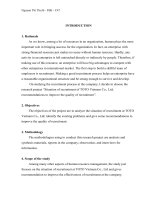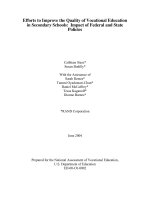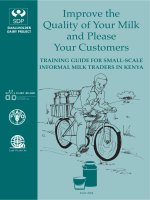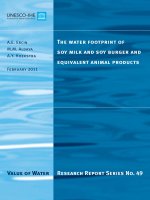Improve the Quality of Your Milk and Please Your Customers pdf
Bạn đang xem bản rút gọn của tài liệu. Xem và tải ngay bản đầy đủ của tài liệu tại đây (520.19 KB, 32 trang )
Improve the
Quality of Your Milk
and Please
Your Customers
TRAINING GUIDE FOR SMALL-SCALE
INFORMAL MILK TRADERS IN KENYA
MAY 2004
SMALLHOLDER
DAIRY PROJECT
SDP
Land O’Lakes Inc
ILRI
INTERNATIONAL
INSTITUTE
LIVESTOCK RESEARCH
DFID
Department for
International
Development
MoL FD
Land O’Lakes Inc
M
FD
Mo
L
IMPROVE THE QUALITY OF YOUR MILK
AND PLEASE YOUR CUSTOMERS
TRAINING GUIDE FOR SMALL-SCALE
INFORMAL MILK TRADERS IN KENYA
MAY 2004
IMPROVE THE QUALITY OF YOUR MILK AND PLEASE YOUR CUSTOMERS
ii
TRAINING GUIDE FOR SMALL-SCALE INFORMAL MILK TRADERS IN KENYA
iii
PREFACE
About this guide
This Training Guide for Traders covers milk quality
and testing requirements for small-scale milk traders
in Kenya. It has been produced through collaboration
between:
● The Kenya Dairy Board (KDB)
● The Food and Agriculture Organization of the
United Nations (FAO) Animal Production
Service
● The Smallholder Dairy Research and
Development Project (SDP) funded by the
British Department for International
Development and operated by the Ministry of
Livestock and Fisheries Development the
Kenya Agricultural Research Council and the
International Livestock Research Institute.
● Land O’Lakes Inc.
In Kenya, small-scale milk traders currently dominate
the marketing of milk. This guide is aimed at filling
an important gap in the provision of training materials
for improvement of milk quality in the country by
addressing the specific needs of small-scale milk
businesses.
IMPROVE THE QUALITY OF YOUR MILK AND PLEASE YOUR CUSTOMERS
iv
There is a Training Guide for Trainers of Small-scale
Milk Traders in Kenya that accompanies this guide for
use during formal training sessions, which outlines
the key lessons to impart during training that will
ensure that milk traders obtain the maximum benefit
from the training. The contents are easy to use and
practical.
Once this course has been successfully completed,
participants may wish to gain more knowledge by
attending one of the certificate-level short courses on
Hygienic Milk Handling and Processing or Milk Testing
and Quality Control at the Naivasha Dairy Training
Institute.
Paul Gichohi
Managing Director
Kenya Dairy Board,
Nairobi ____________________
Angela Wokabi
Manager, MoLFD/KARI/ILRI
Smallholder Dairy Project,
Nairobi ____________________
Brian Dugdill
Re-structuring the
Kenya Dairy Board Project,
FAO, Rome ____________________
Nairobi, May 2004
TRAINING GUIDE FOR SMALL-SCALE INFORMAL MILK TRADERS IN KENYA
v
LIST OF ABBREVIATIONS AND ACRONYMS
DFID Department for International
Development
FAO Food and Agriculture Organization
of the United Nations
ILRI International Livestock Research
Institute
KARI Kenya Agricultural Research
Institute
KDB Kenya Dairy Board
LOL Land O’ Lakes
MoLFD Ministry of Livestock and Fisheries
Development
SDP Smallholder Dairy Project
SNF Solids-Not-Fat
IMPROVE THE QUALITY OF YOUR MILK AND PLEASE YOUR CUSTOMERS
vi
THIS GUIDELINE WILL HELP YOU LEARN:
FACTORS RELATED TO MILK SPOILAGE 2
WHY YOU NEED TO KNOW ABOUT MILK
QUALITY CONTROL 3
WHAT IS MILK QUALITY CONTROL 4
HOW TO ENSURE GOOD QUALITY MILK 4
1. Advice to give to farmers 4
2. Hygienic milk handling 8
3. How to test if milk is acceptable 11
4. How to preserve milk to reduce spoilage 17
OTHER SOURCES OF INFORMATION 20
TRAINING GUIDE FOR SMALL-SCALE INFORMAL MILK TRADERS IN KENYA
1
INTRODUCTION
As a milk trader, you are aware that no other food
gets spoilt more easily than milk. Just as people like
milk for its nutritive value, bacteria that cause milk
spoilage also do. This guide is designed to help you
learn how to reduce the losses caused by spoilage to
allow you to increase your profits. The guide has been
put together with the participation of a pilot group of
small-scale raw milk traders in various parts of Kenya
to ensure that the material and methods suggested
are relevant, simple and practical, thus making them
directly applicable within your circumstances.
Improving your image as a quality milk trader should
ensure customer satisfaction and more sales for your
business. The guide is designed for use in a short
formal training programme covering four days.
However, any milk trader can also easily read and
apply the illustrated instructions and methods.
IMPROVE THE QUALITY OF YOUR MILK AND PLEASE YOUR CUSTOMERS
2
FACTORS RELATED TO MILK SPOILAGE
There are many constraints or problems that milk traders face in
marketing their milk. Many of these constraints or problems cause
milk spoilage or are the result of it. These may include the following
factors:
● Long distance or time between collection and resale point
● Type of containers used
● How the containers are washed
● Method of preservation
● Low profits
● Lack of training
All these factors relate to milk spoilage. Traders are aware of most
of the causes and effects of milk spoilage. The relationship between
the traders and various stakeholders in milk marketing, whether
positive (e.g. provision of training) or negative (e.g. arrests) also
has an influence on their business and the quality of milk that
they sell. In a formal training session, the trainer can discuss more
examples of these relationships.
TRAINING GUIDE FOR SMALL-SCALE INFORMAL MILK TRADERS IN KENYA
3
Bacterial multiplication
24 816321,048,576
Potential sources of contamination
WHY YOU NEED TO KNOW ABOUT MILK QUALITY CONTROL
Milk has nutrients that make it suitable for the rapid multiplication
of bacteria that cause spoilage. Unhygienic production, poor handling
and undesirable practices such as addition of water or other substances
can introduce bacteria or germs that cause spoilage. The resulting
wastage can make you lose profits that you would have otherwise
made. Unhygienic handling may introduce disease-causing bacteria
into the milk and this can also adversely affect human health. In
addition, regulatory authorities will likely require that you undergo
a training course that covers the contents of this guide before they
issue you with a licence to trade in milk. This course is therefore
designed to provide the relevant knowledge and skills needed to
handle milk hygienically.
IMPROVE THE QUALITY OF YOUR MILK AND PLEASE YOUR CUSTOMERS
4
Wash hands with soap
WHAT IS MILK QUALITY CONTROL?
Milk quality control is the practice of specified hygienic methods
and use of approved tests to ensure good milk quality. The good
hygienic practices and tests are designed to help reduce milk
spoilage (See Section 1-3 for details on these methods and tests).
You will need to practice the tests with a trainer to ensure that you
are able to use them properly.
HOW TO ENSURE GOOD QUALITY MILK
Milk from the udder of a healthy cow contains very few bacteria.
Poor hygiene introduces additional bacteria that make the milk
spoil quickly. To ensure that the milk remains fresh for a longer
time it is necessary to practice good hygiene. Good hygiene needs
to be observed at all stages of milk production, handling and
marketing. Therefore you need to advise the farmer on hygienic
milk production and handling after milking.
1) Advice to give to farmers
Quality control must begin at the farm. That way, the milk that
you collect will have fewer bacteria that cause spoilage. Below is
some advice that you can give to the farmers who supply you with
milk, in order to ensure good quality:
● Maintain clean and healthy cows
● Keep a clean milking
environment
● Wash hands with soap and clean
water before milking
TRAINING GUIDE FOR SMALL-SCALE INFORMAL MILK TRADERS IN KENYA
5
● Wash the
udder with
a clean
cloth and
warm water
● Dry the
udder with
a clean dry
cloth
● Make the
first draw
Make the first draw into a strip cup and throw away
Wash udder with a clean cloth
into a strip cup to check for mastitis and throw away from
the milking area even if it appears clean
IMPROVE THE QUALITY OF YOUR MILK AND PLEASE YOUR CUSTOMERS
6
● Use clean containers for milking
● Cows with mastitis should be milked last and their milk
discarded
● Milk from cows under antibiotic treatment should not be
sold until 3 days after last treatment or as advised by the
veterinarian
● After every milking, dip the teats into an “antiseptic dip”
Use clean containers for milking
After every milking, dip teats into
“antiseptic dip”
TRAINING GUIDE FOR SMALL-SCALE INFORMAL MILK TRADERS IN KENYA
7
● During milking, the milker should not:
a) have long nails, b) sneeze or cough, c) smoke
● Release the cow from the milking area as soon as milking is
finished
● After milking, cover the milk to avoid contamination
● Move the milk to a clean and cool area
During milking, the milker should not
have long nails
sneeze or cough
smoke
After milking, cover the milk to avoid contamination
IMPROVE THE QUALITY OF YOUR MILK AND PLEASE YOUR CUSTOMERS
8
2) Hygienic milk handling
Below are some practical guidelines that you should follow in order
to ensure good milking hygiene;
Always use metal (e.g. aluminium) containers and not plastic
containers.
When transferring milk between containers, pour, do not scoop.
Scooping may introduce spoilage bacteria.
When transferring milk between containers, try to pour, not scoop
TRAINING GUIDE FOR SMALL-SCALE INFORMAL MILK TRADERS IN KENYA
9
Thoroughly scrub the milk container with
warm water and detergent or soap (using
something like a stiff bristled hand brush or
scouring pad)
Before re-using the milk
container,
● Pre-rinse the container
soon after use
● Thoroughly scrub the
container with warm
water and detergent or
soap (using a stiff
bristled hand brush or
scouring pad e.g “Super-
brite”)
● Rinse the container in
running water
Rinse milk container
in running water
IMPROVE THE QUALITY OF YOUR MILK AND PLEASE YOUR CUSTOMERS
10
Dip rinse container in boiling water for at least one minute
Air-dry milk container in the open in inverted position
● Dip-rinse the container in boiling water for at least one
minute
● Air-dry the milk container in the open in inverted position
TRAINING GUIDE FOR SMALL-SCALE INFORMAL MILK TRADERS IN KENYA
11
smell the milk
3) How to test if milk is acceptable
During testing only a small amount (sample) of the milk is used.
For the result of the test to give a true picture of the state of the
milk, it is important to mix milk before obtaining the sample or
testing.
You can ensure that the milk that you receive from the farmer is of
good quality by carrying out one or more of the following four basic
tests.
i) Organoleptic test (Using your senses of sight and smell)
This test should be performed first. It simply
requires the use of the senses of sight and
smell to test the milk. It is easy and
straightforward, allowing you to
segregate poor quality milk before you
receive it. Milk that cannot be
adequately judged this way should be
subjected to other more sensitive and
objective tests. No equipment is
required, but the milk tester must have
good sense of sight and smell.
Procedure:
● Open a can of milk
● Immediately smell the milk and
establish the nature and intensity of
smell, if any. The milk may smell
non-fresh or foreign odours may be
detected
IMPROVE THE QUALITY OF YOUR MILK AND PLEASE YOUR CUSTOMERS
12
● Observe the appearance of the milk. Look at the colour of
milk, any marked separation of fat, colour and physical state
of the fat, foreign bodies or physical dirt
● Touch the milk container to feel whether it is warm or cold.
This may indicate to you how long milk has taken since
milking (if not chilled thereafter) and will influence the
lactometer test for adulteration (see below)
Judgment:
Abnormal appearance and smell that may cause milk to be rejected
could be due to:
● Type of feed or
atmospheric taint
● Cows in late lactation
● Chemical taints or
discolouring
● Advanced
acidification or
souring
Marked separation of fat
may be caused by:
● Milk previously
chilled and subjected
to disturbance during
transportation
● Adulteration with other solids (may also show as sediments
or particles)
● Boiling, if milk fat is hardened
TRAINING GUIDE FOR SMALL-SCALE INFORMAL MILK TRADERS IN KENYA
13
Boil a small amount of milk in a spoon
ii) Clot on Boiling Test
This test is quick and simple. It allows you to detect milk that has
been kept for too long without cooling and has developed high
acidity, or colostral milk that has a very high percentage of protein.
Such milk does not withstand heat treatment hence clot on boiling
test could be positive at a much lower acidity.
Procedure and judgment:
Boil a small amount of milk in a spoon or other suitable container.
If there is clotting, coagulation or precipitation, the milk has failed
the test and should be rejected.
ii) Alcohol Test
The test is quick and simple. The specific type of alcohol used is
known as 'ethanol'. It enables you to detect bad milk that may
have passed the previous two tests because it is more sensitive to
lower levels of acidity. It also detects milk that has been kept for
long without cooling, colostrum or milk from a cow with mastitis.
IMPROVE THE QUALITY OF YOUR MILK AND PLEASE YOUR CUSTOMERS
14
Use a syringe to draw
equal amounts of milk
Mix 2 ml milk
with 2 ml alcohol
sample coagulates, clots
– failed the test
Procedure and judgment:
Use a syringe to draw equal amounts of milk and 70% alcohol
solution in a small tube or glass cup (such as those used to
administer medicine to children). Mix 2 ml milk with 2 ml 70%
alcohol.
If the tested milk sample coagulates,
clots or precipitates, it will have failed
the test and the milk should be
rejected. Because this test is quite
sensitive, milk that passes this test can
keep for some hours (at least two hours)
before it goes bad.
TRAINING GUIDE FOR SMALL-SCALE INFORMAL MILK TRADERS IN KENYA
15
Equipment used for determination of milk density
iv) Lactometer Test
Some unscrupulous milk suppliers adulterate milk with added
water to increase the volume or added solids to make it look
thicker. Addition of anything to milk can introduce bacteria that
will make it spoil quickly. Adulteration of milk is also illegal. Here
is how to test the milk to check whether it has been adulterated.
The test is based on the fact that milk has a heavier weight or
density (1.026 - 1.032 g/ml) compared to water (1.000 g/ml). When
milk is adulterated with water or other solids are added, the density
either decreases (if water is added) or increases (if solids are added).
If milk fat (cream) is added to milk, the density becomes lower.
The equipment used to determine milk density is called a
lactometer. Most lactometers are usually marked from “0”
(representing density of 1.000 g/ml) to “40” (representing density
of 1.040 g/ml).









